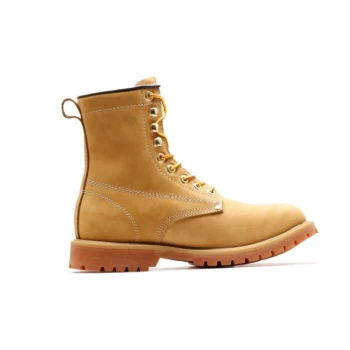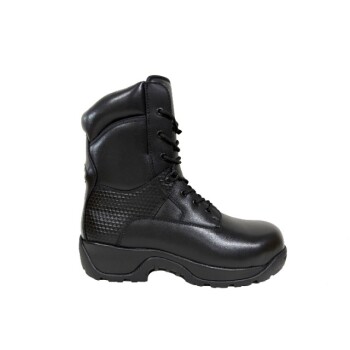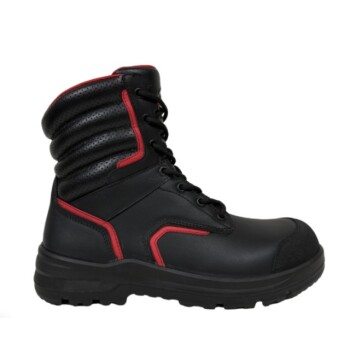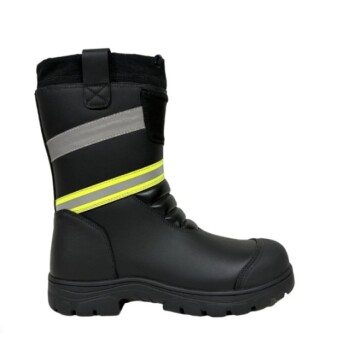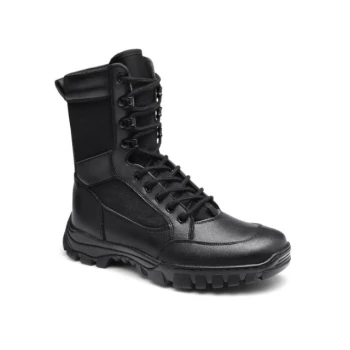The fundamental difference is in how the sole is attached to the rest of the shoe. A Goodyear welt uses a separate strip of leather (the "welt") as a middleman, which is first stitched to the shoe's upper and then stitched to the sole. In contrast, most "regular" shoes are either glued together (cemented construction) or have the upper stitched directly to the sole (Blake stitch).
The choice between Goodyear welt and a "regular" construction is a trade-off between long-term value and immediate cost. A Goodyear welt prioritizes durability, repairability, and water resistance, while more common methods prioritize affordability and initial flexibility.

How a Goodyear Welt Works
The Stitched "Buffer"
Think of the welt as a structural buffer. It’s a ribbon of leather that runs along the perimeter of the upper.
A machine first stitches this welt to the shoe's upper and insole, creating a strong internal connection. This is the first, hidden stitch.
The Outsole Connection
Next, the outsole is separately stitched directly to the welt. This second, visible stitch is what holds the sole on.
Because the outsole is only attached to the welt, a cobbler can easily remove an old sole and stitch on a new one without ever touching or compromising the shoe's upper.
What is "Regular" Construction?
"Regular" typically refers to one of two very common, less labor-intensive construction methods.
The Cemented Method (Glued)
This is the most common method for modern footwear. The outsole is simply attached to the upper using a strong adhesive.
It is fast, inexpensive, and allows for very lightweight and flexible shoes. However, the bond can weaken over time, and resoling is often impossible or not cost-effective.
The Blake Stitch Method
A Blake stitch is a step up from cementing. A single stitch runs from the inside of the shoe, through the insole and upper, and directly into the outsole.
This creates a durable connection and allows for a more flexible, sleeker-looking shoe than a Goodyear welt. However, it compromises water resistance, as water can wick up through the stitch into the shoe's interior.
Key Differences at a Glance
Durability & Repairability
Goodyear welt is the clear winner. The two-level stitch design means the shoe can be resoled multiple times, dramatically extending its life.
Cemented shoes are essentially disposable once the sole wears out. Blake-stitched shoes can be resoled, but it requires a specific machine and is a more complex process.
Water Resistance
Goodyear welt offers superior water resistance. The welt and additional layers create a more robust barrier that prevents water from easily entering the shoe.
Some specialized methods, like the Norwegian or Storm welt, offer even greater protection for extreme conditions. Blake-stitching is more susceptible to water, and cemented shoes can allow water in if the glue seal breaks.
Flexibility & Comfort
"Regular" methods often feel more comfortable out of the box. Cemented and Blake-stitched shoes are typically more flexible from the first wear.
Goodyear welted shoes have a reputation for being stiff initially. They require a break-in period as the layers of leather and cork mold to your foot, but they eventually provide superior, customized support.
Cost & Value
Goodyear welting has a higher initial cost due to the materials and labor involved.
However, its repairability can offer better long-term value. Buying one Goodyear welted pair and resoling it two or three times can be cheaper than buying four pairs of disposable cemented shoes over the same period.
Understanding the Trade-offs
The Break-in Period
Do not expect a Goodyear welted shoe to feel perfect immediately. The robust construction requires time and wear to conform to your foot's unique shape.
The Higher Initial Cost
The price tag can be a significant barrier. A Goodyear welted shoe is an investment in your wardrobe, not an impulse purchase.
The Heavier Profile
The welt and multi-layer construction add some bulk and weight. For the sleekest, most low-profile look, a Blake-stitched or cemented shoe is often superior.
Making the Right Choice for Your Goal
- If your primary focus is long-term value and durability: Choose a Goodyear welted shoe as a foundational investment that can last for years with proper care.
- If your primary focus is immediate comfort and affordability: A cemented construction is a practical choice for casual shoes or footwear you don't plan to wear for many seasons.
- If your primary focus is a sleek profile and flexibility: A Blake-stitched shoe offers a quality middle ground, providing a more elegant look than a Goodyear welt.
Ultimately, understanding these construction methods empowers you to choose footwear that truly aligns with your needs and budget.
Summary Table:
| Feature | Goodyear Welt | Cemented (Regular) | Blake Stitch (Regular) |
|---|---|---|---|
| Durability & Repairability | Excellent (Easily Resolable) | Poor (Often Disposable) | Good (Complex Resoling) |
| Water Resistance | Superior | Fair (Seal Dependent) | Fair (Stitch Entry) |
| Initial Flexibility/Comfort | Stiff (Requires Break-in) | High | High |
| Long-Term Value | High (Investment Piece) | Low (Short Lifespan) | Medium |
| Typical Cost | Higher Initial Cost | Lower Initial Cost | Moderate Cost |
Ready to Invest in Durable, High-Quality Footwear?
As a large-scale manufacturer, 3515 produces a comprehensive range of footwear for distributors, brand owners, and bulk clients. Our production capabilities encompass all types of shoes and boots, including durable Goodyear welted constructions designed for long-term value and performance.
Let us help you build a product line that meets your customers' demands for quality and durability. Contact our team today to discuss your manufacturing needs and get a quote.
Visual Guide
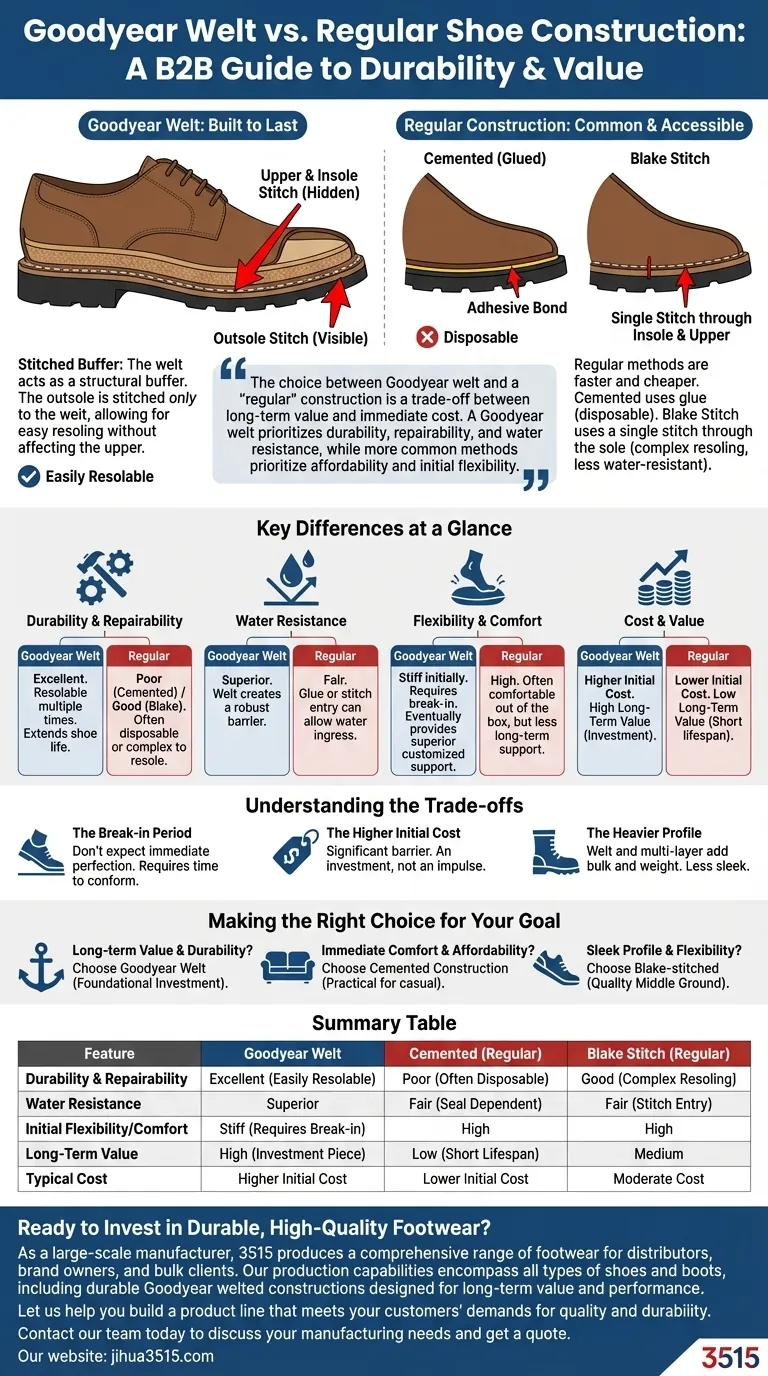
Related Products
- Safety Footwear Wholesale Manufacturer for Custom OEM/ODM Production
- Durable Goodyear Welt Leather Work Boots for Wholesale & Private Label
- Wholesale Leather Work Boots with Customizable Wedge Sole for Brands
- Durable Leather Work Boots for Wholesale & Custom OEM Manufacturing
- Durable Leather Work Boots for Wholesale & Custom Manufacturing
People Also Ask
- How long can you wear safety boots? The Lifespan is Determined by Wear, Not Time
- Do snake bite boots work? Your Ultimate Guide to Effective Snake Bite Protection
- What are OSHA approved shoes? Understanding the Correct Standards for Workplace Safety
- What cultural and environmental considerations are tied to wearing shoes indoors? Balance Hygiene, Tradition, and Foot Health
- What are the cultural perspectives on wearing shoes in the house? A Guide to Home Etiquette & Hygiene

